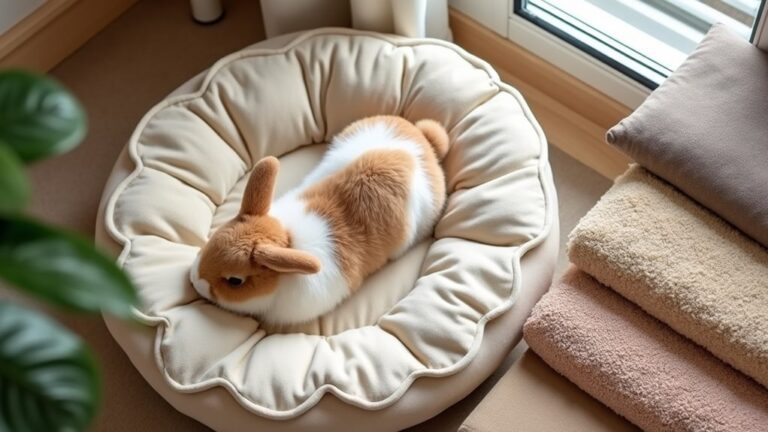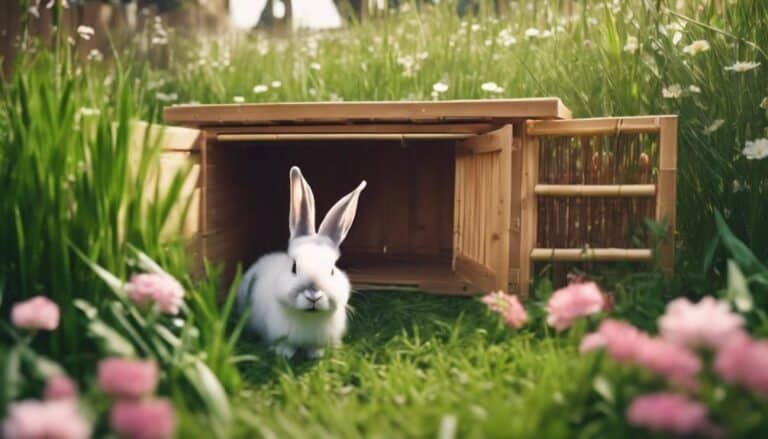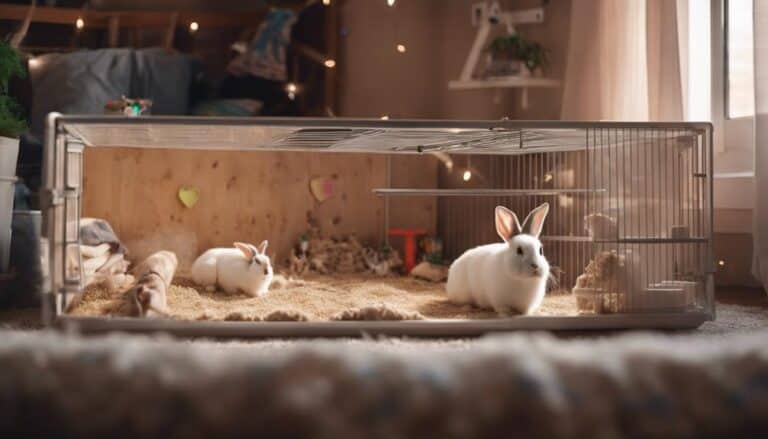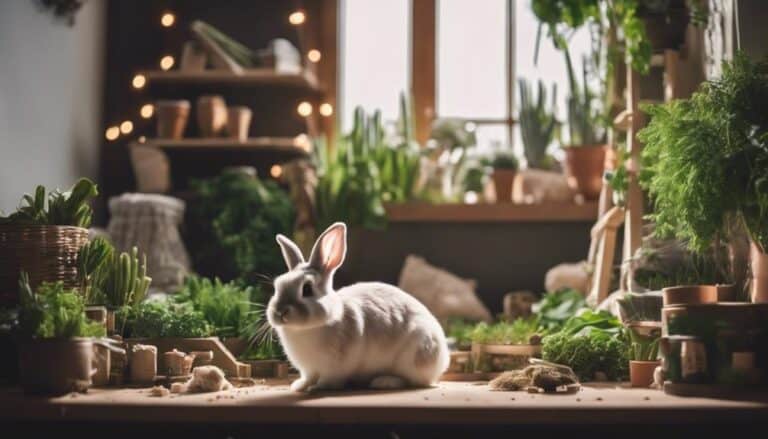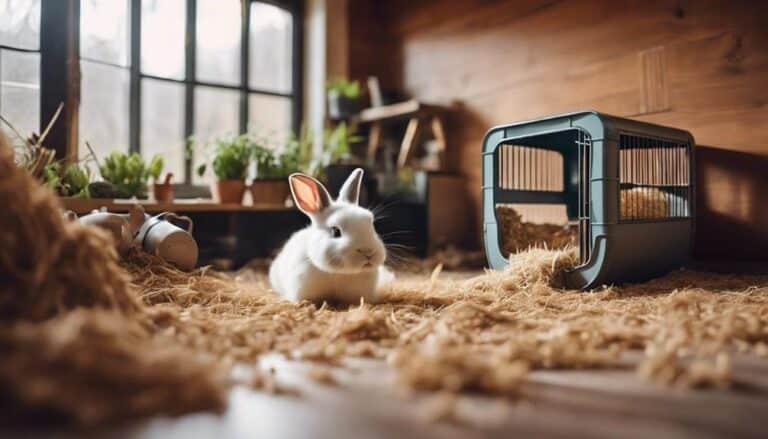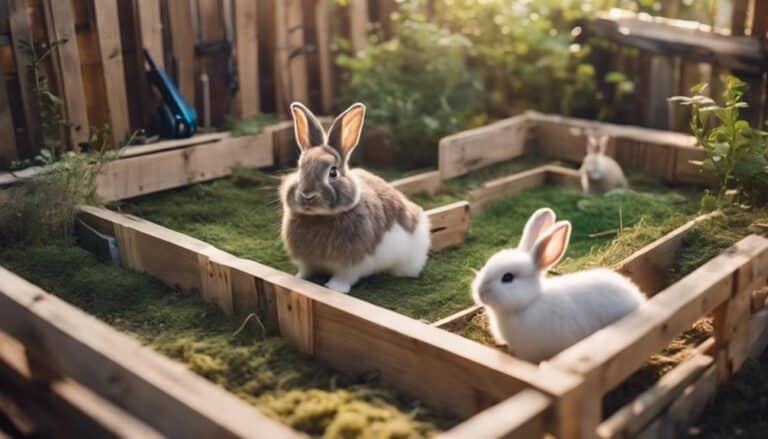Have you ever wondered what it takes to create a safe and enriching environment for your beloved bunny?
From suitable housing to providing a balanced diet and veterinary care, there are key elements to contemplate for your furry friend's well-being.
Understanding the essential tips for a healthy bunny habitat can make a significant difference in their quality of life.
Contents
- 1 Key Takeaways
- 2 Suitable Housing for Rabbits
- 3 Indoor Vs. Outdoor Environment
- 4 Bedding and Resting Areas
- 5 Exercise Area and Playtime
- 6 Protection From Predators
- 7 Ventilation and Temperature Control
- 8 Hygiene and Hazard Prevention
- 9 How Can a Healthy Bunny Habitat Help Prevent GI Stasis in Bunnies?
- 10 Frequently Asked Questions
- 11 Conclusion
Key Takeaways
- Provide ample space, ventilation, and security for rabbits' housing needs.
- Offer a safe and weatherproof indoor or outdoor environment with hiding spots.
- Use hay and straw for bedding, ensuring dry and clean resting areas.
- Create a stimulating play area with toys, supervision, and fresh water for exercise.
Suitable Housing for Rabbits
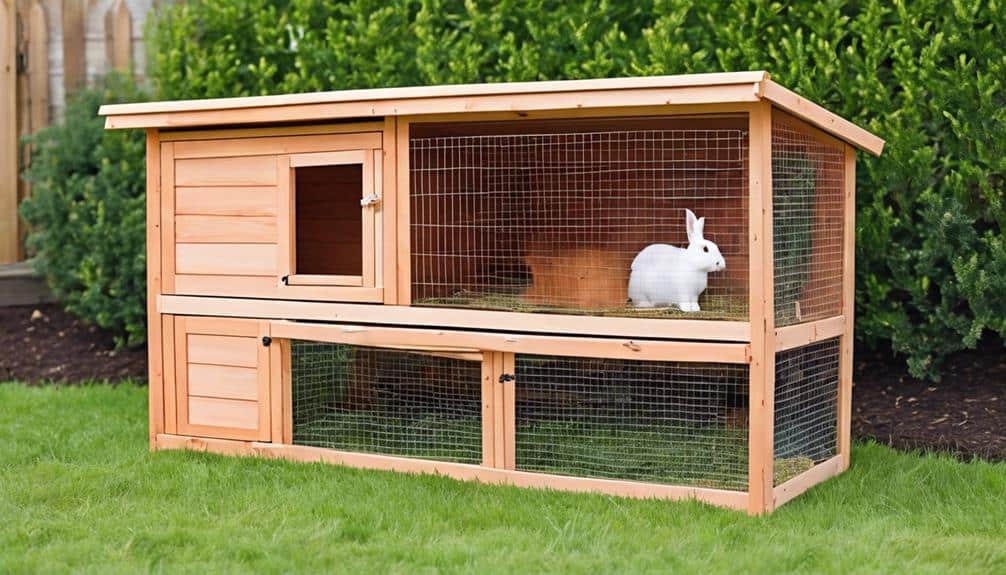
When setting up suitable housing for rabbits, always prioritize providing ample space for movement and exercise to guarantee their well-being and health. Rabbits need enough room to hop, stretch, and explore comfortably. A spacious enclosure not only promotes physical activity but also prevents health issues related to inactivity.
Make sure the rabbit housing has good ventilation to maintain fresh air circulation. Proper ventilation helps prevent respiratory problems that can arise from poor air quality. Additionally, protect the rabbits from predators by using sturdy materials to secure the housing. Predators pose a significant threat to rabbits, so it's important to create a safe and secure environment for them.
Incorporate hiding spots within the housing to help rabbits feel secure. These hiding spots provide rabbits with a sense of safety and security, reducing stress and promoting their overall well-being.
Regularly clean and make sure the housing stays dry to prevent health issues and maintain a comfortable living space for your rabbits.
Indoor Vs. Outdoor Environment
For a thorough understanding of creating a healthy environment for your rabbit, considering the advantages and challenges of both indoor and outdoor settings is essential. Indoor accommodation provides a secure environment, protecting your rabbit from predators and extreme temperatures. It's important to avoid placing your rabbit near heat sources to prevent overheating. Make sure the indoor habitat is draught-free and weatherproof to maintain your rabbit's health.
On the other hand, outdoor housing should be secure, well-ventilated, and include an exercise run for your rabbit's physical activity. Providing safe hiding places in both indoor and outdoor environments is important for your rabbit to feel secure and reduce stress. Remember to create a weatherproof environment outdoors to protect your rabbit from the elements.
Ultimately, whether you choose an indoor or outdoor habitat for your rabbit, ensuring a secure environment, proper ventilation, and the availability of hiding spots are key aspects to take into account in creating a healthy and happy living space for your furry companion.
Bedding and Resting Areas
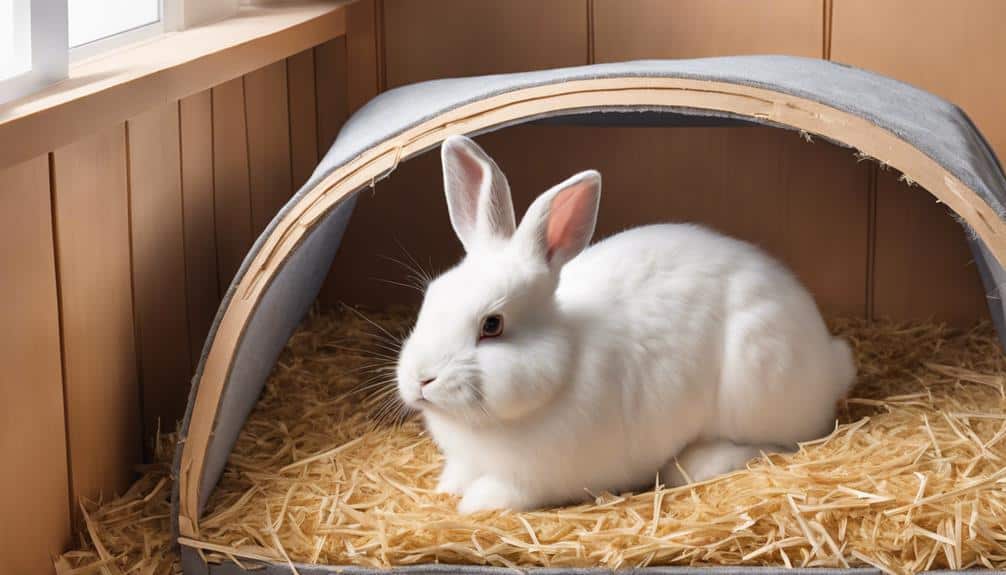
Consider utilizing a combination of hay and straw as appropriate bedding materials for your rabbit's habitat. Hay provides a soft and comfortable surface for your bunny to rest on, while straw helps with insulation and absorbs moisture. Make sure that the resting areas are well-ventilated, dry, and draught-free to prevent respiratory issues and keep your rabbit comfortable.
Providing separate compartments for sleeping and eating/relaxing is crucial to give your bunny a sense of security and privacy. Avoid using wood shavings as bedding, as they can be harmful if ingested by your rabbit. Keep the bedding clean and dry by regularly changing it to maintain a hygienic environment.
Rabbits are sensitive animals that thrive in environments that cater to their natural behaviors and needs. By creating a cozy and safe resting area with suitable bedding materials, you're promoting your rabbit's overall well-being and happiness.
Exercise Area and Playtime
To secure your bunny remains active and healthy, creating a spacious and secure exercise area is crucial. When setting up an exercise area and playtime for your bunny, consider the following tips to guarantee their well-being:
- Include a variety of toys: Toys like tunnels and balls can keep your bunny entertained and physically active, promoting exercise and mental stimulation.
- Rabbit-proof the play area: Make sure the space is safe by removing any potential hazards or toxic items that your bunny could chew on.
- Rotate toys regularly: Keep your bunny engaged by introducing new toys or rotating existing ones to prevent boredom.
- Supervise playtime: By actively monitoring your bunny during playtime, you can ensure their safety, observe their behavior, and intervene if necessary.
Remember to provide fresh water and create a safe environment where your bunny can exercise, play, and thrive under your watchful care.
Protection From Predators
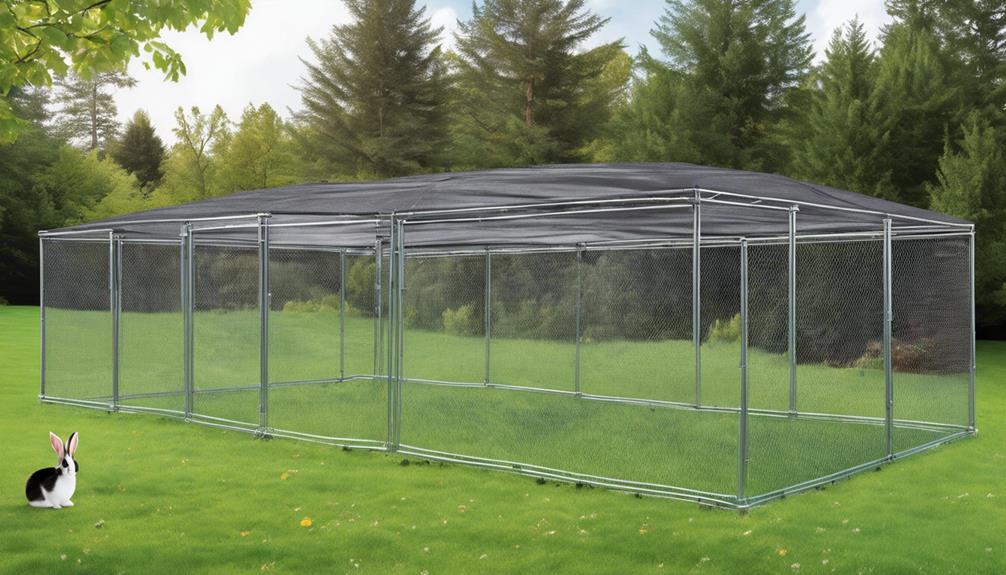
When ensuring the safety of your bunny habitat, safeguarding against potential predators is paramount for their well-being and security. Predators such as foxes, raccoons, birds of prey, and even domestic pets like cats and dogs pose a threat to your rabbits.
To protect your furry friends, it's essential to secure hutches and runs with sturdy materials like wire mesh. Make sure that the hutches have a solid base to prevent digging predators from burrowing in. Use predator-proof locks and latches on doors and gates to keep your rabbits safe and sound inside.
For added security, consider installing motion-activated lights or alarms to deter nocturnal predators. These deterrents can help keep predators at bay and provide your bunnies with a safe and secure environment to hop around in.
Ventilation and Temperature Control
For essential health and comfort of your bunnies, ensuring proper ventilation and temperature control in their habitat is crucial. Here are some critical tips to help you create an ideal environment for your furry friends:
- Fresh Air: Providing good ventilation helps keep the air inside the habitat fresh, reducing the risk of respiratory issues in your rabbits.
- Respiratory Health: Proper airflow is essential for maintaining your rabbits' respiratory health and preventing any breathing problems.
- Temperature Regulation: Well-ventilated spaces help regulate the temperature, ensuring your bunnies aren't exposed to extreme heat or cold.
- Ammonia Buildup and Mold Prevention: Adequate ventilation plays a key role in preventing the accumulation of harmful gases like ammonia and inhibiting mold growth, creating a healthier living space for your bunnies.
Hygiene and Hazard Prevention
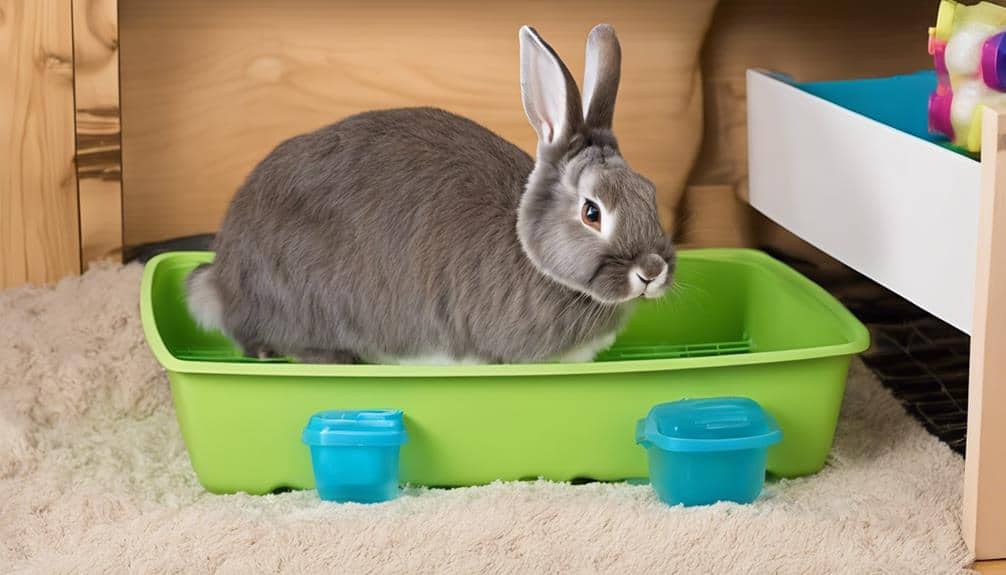
Maintaining a clean and vital environment is key to making sure the well-being and safety of your rabbits within their habitat. Provide fresh water daily and keep an eye out for signs of illness to address any health issues promptly.
When it comes to hygiene, use newspaper or shredded paper in the litter tray to keep the toilet area clean. Clean the living areas daily, replacing wet bedding to prevent odor and bacteria buildup. Secure any potentially toxic substances such as cleaning chemicals to prevent accidental ingestion by your pet rabbits.
Additionally, when you need to transport rabbits, make sure their safety by using a carrier to avoid stress and injuries during travel. It's essential to have daily care routines in place and emergency contact details accessible for quick assistance in case of any unforeseen emergencies.
How Can a Healthy Bunny Habitat Help Prevent GI Stasis in Bunnies?
Creating a healthy bunny habitat is essential for preventing GI stasis in bunnies. Providing a balanced diet, ample exercise, and a clean living environment are crucial preventing GI stasis tips. Including plenty of fresh hay and safe chew toys can also support your bunny’s digestive health, lowering the risk of GI stasis.
Frequently Asked Questions
What Are Health Tips for Bunnies?
For a healthy bunny, focus on a proper diet, regular exercise, a clean environment, mental stimulation, social interaction, grooming routine, and safe play areas. These elements contribute to a happy and thriving bunny companion.
What Are 4 Things Rabbits Need to Survive?
To survive, rabbits need a balanced diet of hay, fresh greens, and limited treats for nutrition. They require regular exercise, social interaction, grooming, a safe environment, mental stimulation, and health checkups to guarantee their well-being and happiness.
What Are the Essentials for Rabbits?
To keep your bunny healthy, focus on diet, exercise, housing, grooming, enrichment, socialization, and vet care. Provide fresh veggies, space to hop around, a safe hutch, regular brushing, toys, playtime, rabbit companions, and check-ups.
What Is a Good Rabbit Habitat?
In creating a great rabbit habitat, make sure there's enough space, cozy bedding, safe places to hide, and varied enrichment. Maintain ideal temperatures, groom regularly, provide a nutritious diet, and set up a secure environment.
Conclusion
As you create a healthy habitat for your bunny, remember that each element plays a vital role, much like pieces of a puzzle coming together to form a complete picture.
Just as a puzzle requires patience and attention to detail, so too does caring for your furry friend.
By ensuring proper housing, protection, and care, you aren't just providing a safe environment for your bunny, but also creating a beautiful masterpiece of love and companionship.

